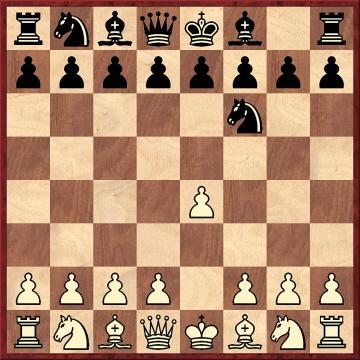
Edward Winter

Michael McDowell (Newtownards, Northern Ireland) suggests that The World of Chess by A. Saidy and N. Lessing (New York, 1974) has a large number of errors. On page 174 we learn that Alekhine ‘introduced the defense which bears his name (1 P-K4 N-KB3), but, oddly enough, never played it again’. Of course, this is untrue, although it is accurate to say that Alekhine became rather disillusioned with the defence in later years. What is particularly interesting is how such an historical blunder can be made in the first place.
(112)
An endnote on page 259 of Chess Explorations stated:
For example, Alekhine played Alekhine’s Defence against Nimzowitsch at Semmering, 1926, Dresden, 1926 and New York, 1927, losing the first game and drawing the other two.
From C. Derek Robinson (Toronto, Canada):
‘The howler about Alekhine’s solitary use of the defence bearing his name antedates Saidy and Lessing. It goes back at least as far as R.N. Coles’ Dynamic Chess (London, 1956) – his introduction to A. Steiner v Alekhine, Budapest, 1921.’
(248)
On page 259 of Chess Explorations we added:
An earlier instance was page 43 of CHESS, 14 October 1935.
Hugh Myers (Davenport, IA, USA) points out that on page 140 of Paul Keres Chess Master Class by I. Neishtadt (Oxford, 1983) it is stated that Alekhine’s Defence ‘had been employed earlier by the Moscow player M. Klyatsky’. Is this, he asks, the Mikhail G. Klyatskin, 1897-1926, in Gaige’s Catalog? Mr Myers informs us that 1 e4 Nf6 received some publicity from its use in tournament odds games by Pearson in 1862, but that Russians should have known about it for a long time (it was in A. Petroff’s Shakhmatnaya igra, 1824). Petroff no doubt picked it up from Allgaier; both gave 2 e5 Ne4 although in 1824 Petroff did mention 2...Nd5 3 c4 with the idea of 4 d4. Which was the earliest Allgaier edition to give what was subsequently ‘Alekhine’s Defence’?
(646)
From Bernard Cafferty (St Leonards-on-Sea, England):
‘The Russian version of the Keres book gives Klyatskin, a study composer who liked 1 e4 Nf6. See page 165 of the first volume of Tartakower’s Best Games for a linking of Klyatskin and Alekhine as the names for this defence.’
The question at the end of C.N. 646 is answered by Rob Verhoeven (The Hague, the Netherlands), who sends a photocopy of an extract from the first edition of Allgaier’s work (Vienna, 1819). The moves given are 1 e4 Nf6 2 e5 Nd5 3 c4 Nb6 4 d4 d6 5 f4 f6 6 Bd3 dxe5 7 fxe5 fxe5 8 Qh5+ Kd7 Qxe5, with the variation 4...e6 5 f4 Bb4+ 6 Nd2.
(734)
The book also gave 1 e4 Nf6 2 e5 Ne4 3 d3 Nc5 4 d4 Ne6 5 d5 Nc5 6 b4 Nca6 7 a3. A note on page 108 stated that 7 Bxa6 was also playable.
Hugh Myers writes:
‘That doesn’t quite answer the question because Vienna, 1819 was the fourth edition of Allgaier ... The first two editions were 1795/1796 and 1802. I would like to know what those editions say about “Alekhine’s Defence”, as compared to the 1819 edition.’
Rob Verhoeven tells us that the 1819 fourth edition of Allgaier was the first in which ‘Alekhine’s Defence’ was mentioned.
One day justice will be done to that remarkable Austrian polymath Dr Josef Krejcik, a recurring name throughout decades of the Wiener Schachzeitung’s existence. From pages 215-216 of the July 1925 issue comes this agreeable little game under the title ‘A New Gambit’ (‘Ein neuartiges Gambit’):
Josef Emil Krejcik – Dr Fr. Schmuttermaier
Reinberg-Dobersberg, 9 August 1924
‘Krejcik Gambit’
1 e4 Nf6 2 f3 e5 3 Bc4 Bc5 4 Ne2 Nc6 5 b4 Bb6 6 a4 Nxb4 7 a5 Bc5 8 c3 Nc6 9 a6 bxa6 10 d4 exd4 11 cxd4 Bb4+ 12 Bd2 Bxd2+ 13 Qxd2 d5 14 exd5 Nxd5 15 Nbc3 Nxc3 16 Qxc3 Qd6 17 Bxa6 Bxa6 18 Rxa6 Kd7 19 O-O Rhe8 20 Rc1 Re6 21 d5 Qxd5 22 Nf4 Qd4+ 23 Qxd4+ Nxd4 24 Nxe6 Ne2+ 25 Kf2 Nxc1 26 Nc5+ Ke7
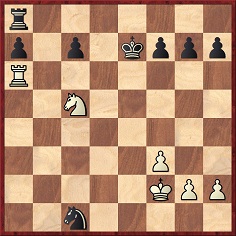
27 Ra1 Resigns. Domination.
The annotations reveal that the ‘stem game’ of this opening was Krejcik-Bourqui (6 January 1924), which had continued: 5...Bxb4 6 c3 Bc5 7 d4 exd4 8 cxd4 Bb4+ 9 Bd2 Bxd2+ 10 Qxd2 d6 11 Nbc3 O-O 12 O-O a6 13 Rab1 b5 14 Bd3 Rb8 15 Rfc1.
Another of Krejcik’s early experiments is mentioned: 1 e4 Nf6 2 Bc4 Nxe4 3 Bxf7+ Kxf7 4 Qh5+ g6 5 Qd5+, etc. (match-game against Gottlieb, March 1922).
(696)
Pages 47-48 of Artige und unartige Kinder der Schachmuse by J. Krejcik (Leipzig, 1925) provide an addition to C.N. 696. Entitled ‘Kürzestes Lehrbuch der Eröffnungslehre’ (‘Shortest Textbook of Opening Theory’), Krejcik’s offering comprised just the following:
‘Krejciksgambit
1 e2-e4 Sg8-f6 2 f2-f3 e7-e5 3 Lf1-c4 Lf8-c5 4 Sg1-e2 Sb8-c6 5 b2-b4 und gewinnt.
Diese Kombination Aljechin-Damiano-Evans ist meine Erfindung und macht jedes weitere Studium überflüssig.’
Translation: ‘This Alekhine-Damiano-Evans combination is my discovery and makes all further study superfluous.’
(3305)
At Budapest, 1926 Alekhine’s Defence was played 15 times, and the Queen’s Indian Defence 24, much more than any other openings in the tournament. Why? (For example, there were six French Defences, one Caro-Kann and nine Sicilians, so Alekhine’s Defence all but outnumbered the other semi-open defences combined.)
(1135)
We now note that pages 42-43 of the January 1898 BCM published the following game:
Thomas Physick – John Edmund Hall(Notes from The Standard, reproduced in the BCM)
‘1 e4 Nf6 (Mr Hall is very partial to this move; but we have never seen it adopted by any other player. Prima facie it is contrary to principles (as second player), and practically the knight being attacked it is driven over to the queen’s side, where it out [sic] of play after having lost several moves.) 2 e5 Nd5 3 Bc4 (3 c4 is preferable. White loses a move with 3 Bc4.) 3...Nb6 4 Be2 d5 5 d4 Bf5 6 Nf3 e6 7 O-O c5 (The position is now a French Defence, similar to the variation 4 e5 Nfd7, etc.) 8 c3 Nc6 9 Be3 Nd7 10 Bd3 Bxd3 11 Qxd3 Be7 12 Nbd2 O-O 13 Ne1 f6 (He might have played 13...f5. White would have probably replied 14 f4, when Black’s e-pawn would have been safer than afterwards.) 14 f4 c4 (Even now we prefer 14...f5, followed by 15...cxd4 and 16...Qb6 or 16...Qe8. Or 14...fxe5 15 fxe5 Rxf1+ 16 Nxf1 cxd4 17 cxd4 Qb6, followed by 18...Rf8.) 15 Qe2 fxe5 16 fxe5 Rxf1+ 17 Nxf1 Bg5 18 Qg4 Bxe3+ 19 Nxe3 Qe7 20 Nf3 Rf8 21 Ng5 Nd8 22 Qh5 h6 (With 14...c4 he drove the queen into a better position, thus enabling White to get up a powerful attack.) 23 Nh3 Rf7 24 g3 Nf8 25 Ng2 Rf5 26 Qg4 Kh7 (26...h5 would have driven the queen off the file or forced exchange of queens.) 27 Ngf4 g6 28 Kg2 Nf7 29 Qe2 (Threatening to win the exchange.) 29...Ng5 30 Nf2 Kg7 31 h4 Ngh7 32 Ng4 Nd7 33 Qc2 Qe8 34 Ne3 Rf8 35 h5 g5 36 Ng6 Rf7 37 Qe2 Ndf8 38 Rh1 Rd7 (He should not have quitted the open file.) 39 Nxf8 Nxf8 40 Rf1 Rf7
41 Rf6 (A fine move. If 41...Rxf6, then 42 exf6+ Kxf6 43 Nxd5+ and wins.) 41...Qe7 (Black’s game is untenable.) 42 Ng4 Nh7 43 Rg6+ Kf8 44 Nxh6 Rg7 45 Qg4 Rxg6 46 hxg6 Resigns. (For if 46...Qg7, then 47 Qxe6, etc. Mr Physick played the whole game in fine style, and the ending is a model of precision and elegance.)’
Within a few minutes of coming across the above game we were able to construct a detailed picture of John Edmund Hall (1853-1941) simply by following up the references in Chess Personalia. Without Gaige’s book, this would have been impossible.
(1782)
Another game by the same player has been discovered by Alan Smith and published by him on pages 19-20 of the GMCCA Bulletin (Manchester), Autumn 1999:
S. Ward – John Edmund Hall1 e4 Nf6 2 e5 Nd5 3 d4 d6 4 c4 Nb6 5 Nf3 Bg4 6 exd6 exd6 7 Bd3 Qf6 8 Nbd2 Qe6+ 9 Be2 Be7 10 O-O O-O 11 b3 Bf5 12 Bb2 d5 13 c5 N6d7 14 Re1 Qg6 15 Bd3 Bf6 16 Bxf5 Qxf5 17 b4 c6 18 Nb3 Na6 19 a3 Rfe8 20 Na5 Rxe1+ 21 Qxe1 Rb8
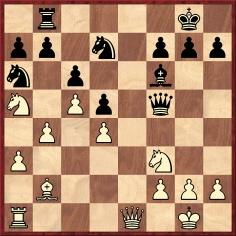
22 Nxb7 Rxb7 23 Qe8+ Nf8 24 Qxc6 Nxc5 25 Qxc5 Re7 26 Ne5 Qe4 27 b5 h6 28 h3 Ne6 29 Qc3 Rc7 30 Qe3 Qc2 31 Bc1 Bg5 32 Qf3 Nxd4 33 Qxd5 Ne2+ 34 Kh1 Nxc1 35 Nf3 Bf6 36 White resigns.
The original source is given as the Bradford Observer Budget, 8 April 1893.
(2357)
Here is the brief death notice of Edward Hymes from page 156 of the June 1938 Chess Review:
‘Mr Hymes was one of America’s finest players in the ’90s and the turn of the century. He distinguished himself in many important team matches, and was noted for his original opening style. For example, he frequently played the defense now named after Alekhine!’
This prompts us to raise the question of when the term ‘Alekhine’s Defence’ was first employed. The great master’s earliest tournament games with 1 e4 Nf6 were at Budapest, 1921 against Sämisch (10 September) and E. Steiner (15 September); these were his only two games in the tournament where the opportunity for that opening arose. The former game was a 24-move draw, but Alekhine annotated his win over Steiner on pages 138-142 of the 2/1922 Kagans Neueste Schachnachrichten. The heading merely named the opening as ‘Irregular’.
Subsequently annotating the game on pages 213-215 of the May 1922 BCM (where the heading was ‘Irregular Opening’), Sir George Thomas wrote:
‘This novel defence was introduced by Alekhine at the Budapest tournament, where he adopted it several times; and since then it has been further tested by other players (in addition to Alekhine) at The Hague and elsewhere. So far, it seems to have stood the test of practice quite well; though there is doubtless much still to be discovered in regard to it. It has been named, tentatively, Alekhine’s Defence; and is clearly a novelty of considerable importance, opening up, as it does, a new field for investigation.’ [The spelling Aljechin has been ‘modernized’ above. Sir George’s reference to ‘several times’ was an error.]
May 1922 was also the date on the cover of the first monograph on the opening, published in Berne: Die Aljechin-Verteidigung by Hans Fahrni. In the first paragraph of the introduction, in which he explained that he was dedicating the booklet (28 pages) to Wilhelm Bonacker, Fahrni wrote that he had decided to call the opening ‘Alekhine’s Defence’. For reference, his exact words were:
‘Anlässlich einer Unterhaltung mit meinem Freund Wilhelm Bonacker in Bern über den Zug 1 Sg8-f6 gegen 1 e2-e4, für welchen ich die Bezeichnung “Aljechin-Verteidigung” hiermit einführe, regte mich dieser starke Schachamateur zu einer improvisierten Skizze über dieselbe an, die ich ihm hiermit freundlichst widme!’
(2597)
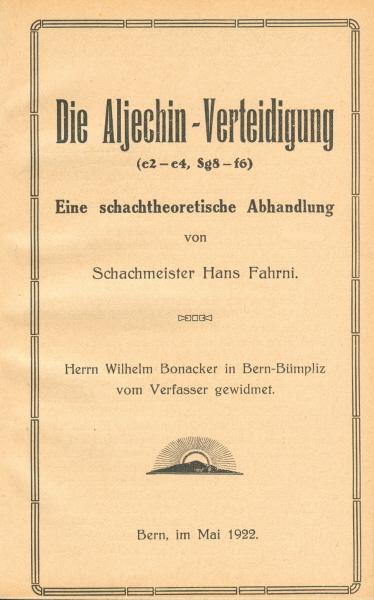
Another excellent issue of the quarterly magazine Kaissiber has come to hand. An article on Mikhail Kliatskin (1897-1926) by Michael Negele and Stefan Bücker entitled ‘Der Mann, der Aljechins Verteidigung erfand’ (‘The man who invented Alekhine’s Defence’) is of particular interest.
(2951)
The earliest instance that we have found of Alekhine playing 1...Nf6 in reply to 1 e4 is in a consultation game against A. Donegan, E. Müller and O. Zimmermann (Zurich, 27 August 1921), as published on pages 165-167 of the November 1921 Schweizerische Schachzeitung:


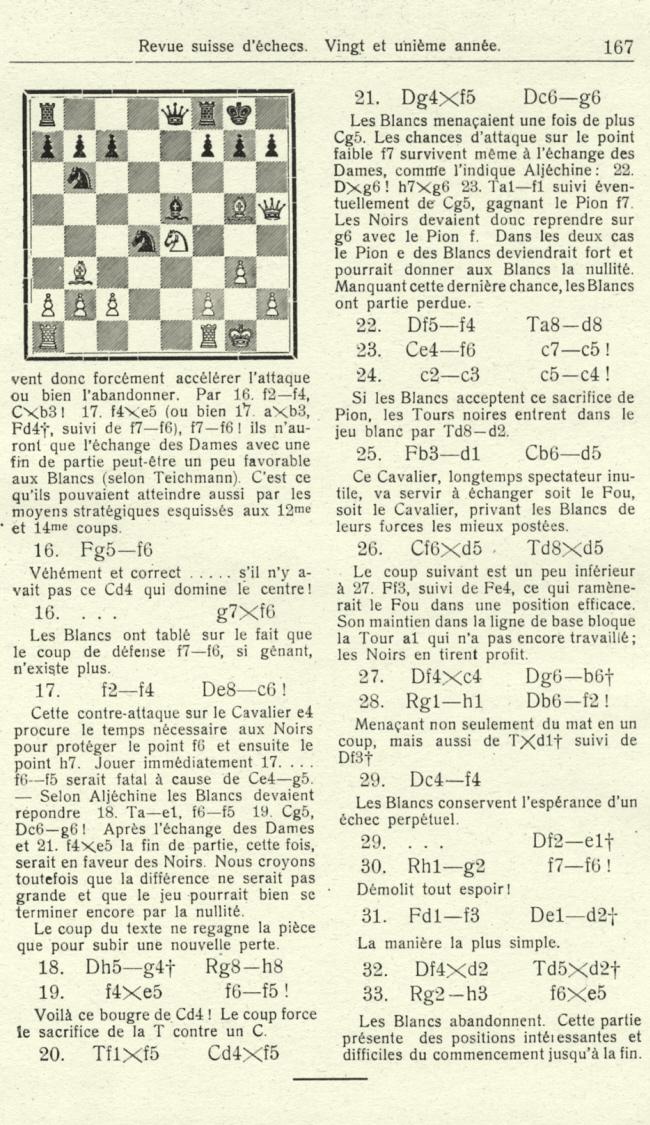
Myron Samsin (Winnipeg, Canada) writes:
‘Page 4 of Byrne J. Horton’s Dictionary of Modern Chess (New York, 1959) states that Alekhine’s Defence “can be traced to the 1862 International Handicap Tournament of London”.
Two games between Anderssen and Pearson in that event did indeed begin 1 e4 Nf6, but White was giving the odds of his queen’s knight. Is it correct to assign an opening name from standard chess to a similar sequence played at odds? I am inclined to think not, because the tactics and themes are different.’
Our preference is not to use opening names for odds games. That, at least, avoids the inconsistency which arises in, for instance, the concluding part of Morphy’s Games of Chess by Philip W. Sergeant (London, 1916). Games played at the odds of the queen’s knight which began 1 e4 e6 are headed ‘French Defence’, but no opening heading appears when 1 e4 e6 occurred in a game in which Black offered the odds of his f-pawn. Another encounter in which Morphy gave the odds of pawn and move began 1 e4 d6, for which it might be difficult to suggest a suitable opening name.
(8103)
Jerry Spinrad (Nashville, TN, USA) notes that pages 210-211 of the Chess Player’s Chronicle, 1862 published a game which began 1 e4 Nf6 and was not played at odds:
Berwick Chess Club – Edinburgh Chess Club
Correspondence, November 1860-15 November 1861
Alekhine’s Defence
1 e4 Nf6 2 e5 Ng8 3 d4 e6 4 Bd3 c5 5 Nf3 cxd4 6 O-O Nc6 7 Re1 d6 8 Bb5 d5 9 Nxd4 Bd7 10 c3 Bc5 11 Be3 Bxd4 12 Bxd4 Nge7 13 Bxc6 Bxc6 14 Qd3 O-O 15 f4 Nf5 16 Nd2 Qh4 17 Rf1 a6 18 a4 f6 19 exf6 gxf6 20 Rf3 h6 21 Nf1 Qh5 22 Rh3 Qf7 23 Ng3 Qh7 24 Nxf5 exf5 25 Qe2 Rae8 26 Rg3+ Kh8
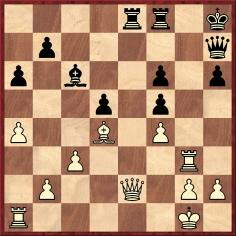
27 Qh5 Re4 28 Qh4 Rxd4 29 cxd4 h5 30 a5 Be8 31 Re1 Qd7 32 Rge3 Bg6 33 Qg3 Bf7 34 Re7 Qb5 35 Qc3 Bg6 36 Qc5 Qxc5 37 dxc5 Rb8 38 Rd1 Be8 39 Rxd5 Bc6 40 Rxf5 Rd8 41 Rxf6 Rd1+ 42 Kf2 Rd2+ 43 Kf1 Resigns.
(8107)
From Alan McGowan (Waterloo, Canada) comes a paragraph by Ernst Jünger (C.N. 8658) about the origins of 1 e4 Nf6 on page 86 of the 1 January 1925 issue of Kagans Neueste Schachnachrichten:
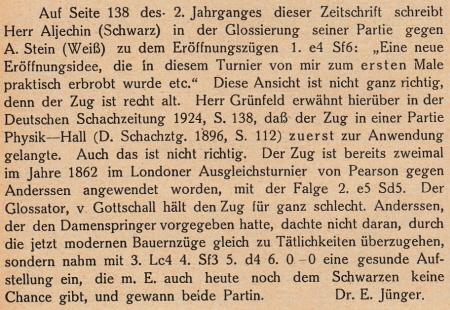
(8665)
John Townsend (Wokingham, England) writes:
‘In Bell’s Life in London, 13 November 1842 George Walker recalls in a reply to a correspondent that Alexander McDonnell (1798-1835) had played an unusual variation of Alekhine’s Defence:
“We have seen McDonnell as his first move, his adversary having begun first, and pushed out king’s pawn two, commence with king’s knight thus to bishop’s third, courting his opponent’s pushing king’s pawn on him, and then coolly retiring knight home, “biding his time”. He used to say his adversary’s king’s pawn was weakened, by being thus prematurely advanced.”
This commentary on the variation 1 e4 Nf6 2 e5 Ng8 suggests that McDonnell possessed some understanding of what we would now regard as hypermodern principles of play.
I note your feature article on Alekhine’s Defence. Had Allgaier already explained any such principles in the course of his analysis?’
Below is the passage by Walker referred to, from page 2 of the 13 November 1842 edition of Bell’s Life in London:
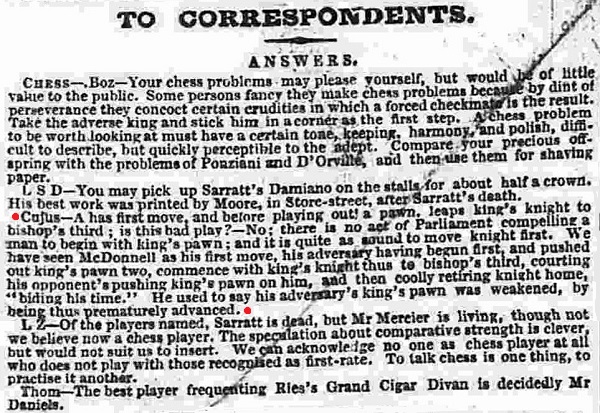
Mr Townsend notes that the item can also be viewed at the Chess Archaeology website as part of the Jack O’Keefe Project. (The Project, we add, represents an astounding amount of work of great value.)
The answer to our correspondent’s question about Allgaier is that no explanation of principles was offered when the moves 1 e4 Nf6 were given in Tafel 9 of his book Neue theoretisch-praktische Anweisung zum Schachspiele (Vienna, 1819):
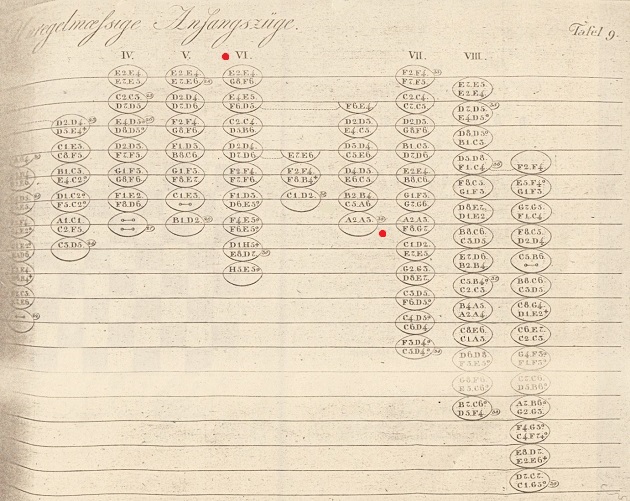
The relevant notes (30, 31 and 32) can be read in the Google Books scan of the work, on page 108.
The connection between Alexander McDonnell and hypermodernism is intriguing.
(9667)
An article by Richard Réti on pages 50-54 of the February 1923 Tijdschrift van den Nederlandschen Schaakbond:
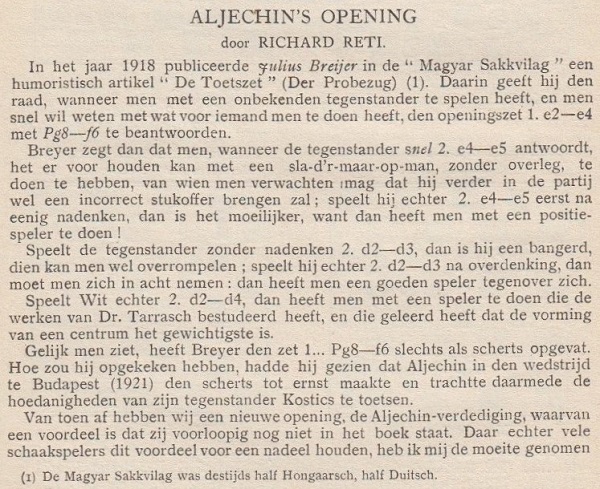
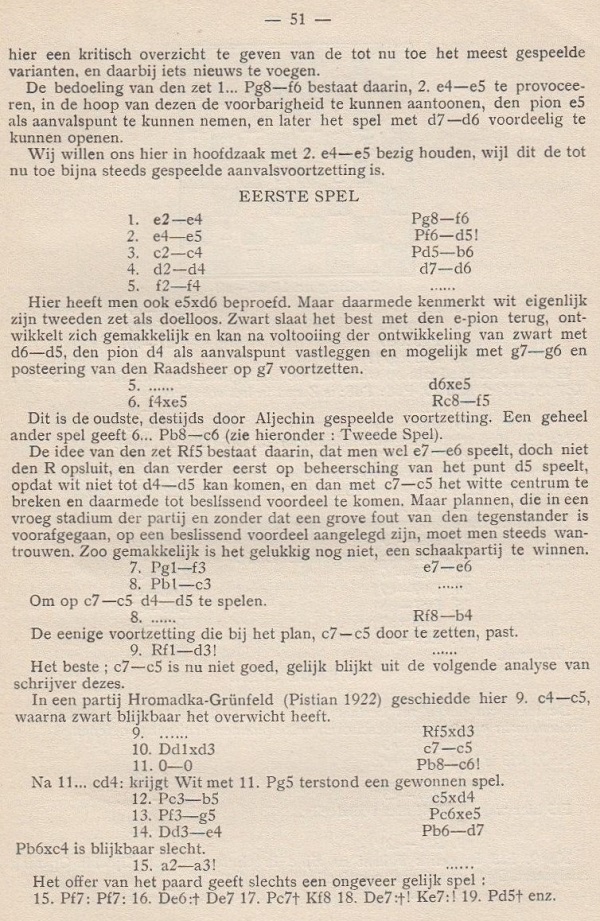

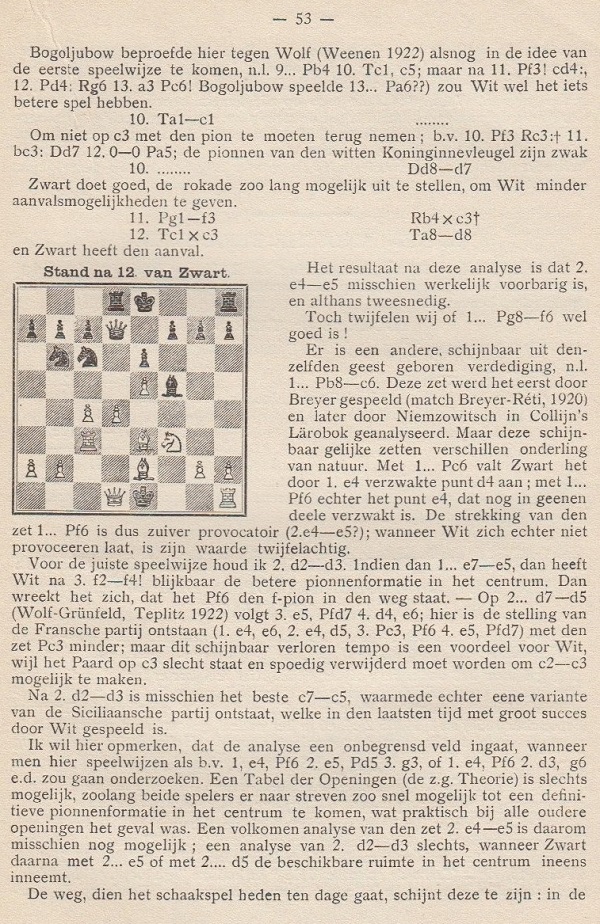
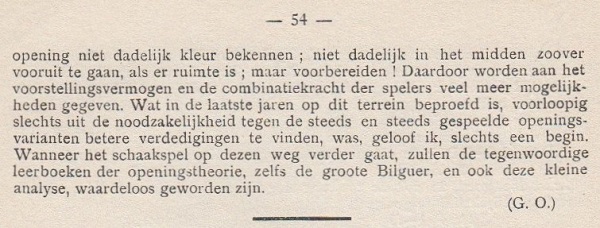
Eduardo Bauzá Mercére (New York, NY, USA) provides an addition (S.L. McCalla-L.D. Barbour, Philadelphia, 17 April 1887) to our small collection of pre-Alekhine specimens of Alekhine’s Defence. It was published on page 16 of the New Orleans Times-Democrat, 1 May 1887:


1 e4 Nf6 2 e5 Ne4 3 d3 Nc5 4 d4 Nca6 5 f4 e6 6 Nc3 Bb4 7 Bd2 c5 8 d5 Bxc3 9 Bxc3 exd5 10 Qxd5 O-O 11 O-O-O Qe7 12 a3 Qe6 13 Qe4 f5 14 Qa4 Kh8 15 Nf3 h6 16 Rd6 Qe7 17 g3 b6 18 Nh4 Kh7 19 Bg2 Nc6 20 Ng6 Qe8 21 Nxf8+ Qxf8 22 Bxc6 dxc6 23 Qxc6 Rb8 24 Rhd1 Bb7

25 Rxh6+ gxh6 26 Rd7+ Kh8 26 Qg6 Resigns.
(10051)
See too:
Also, the feature article Borochow v Fine, Pasadena, 1932. The game began 1 e4 Nf6 2 e5 Nd5 3 d4 Nc6 4 c4 Nb6 5 d5 Nxe5 6 c5 Nbc4.
Regarding Raymond Keene’s treatment of Znosko-Borovsky v Alekhine, Paris, 1925, see a brief article by Olimpiu G. Urcan.
To the Chess Notes main page.
To the Archives for other feature articles.
Copyright: Edward Winter. All rights reserved.